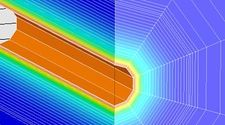
For the past 18 months Quintessa, in conjunction with the University of Edinburgh (UoE) and UFZ Leipzig, have been participating in the DECOVALEX-2011 project, in support of the Nuclear Decommissioning Authority Radioactive Waste Management Directorate.
This work builds on previous DECOVALEX projects aimed at improving understanding of THMC processes, through developing numerical models in comparison with laboratory and field data and using this understanding to improve performance and safety assessments. Quintessa and UoE/UFZ are principally involved in Task A, which uses the micro-tunnel Ventilation Experiment (VE) at the Mont Terri underground laboratory, and associated laboratory experiments as framework for improving understanding of coupled Hydraulic, Mechanical and Chemical (HMC) processes in the Opalinus Clay.
Using the QPAC and Rockflow/GeoSys codes in conjunction with the other groups participating in Task A, significant progress has been made in understanding the coupled Hydro-Mechanical behaviour of the VE and underpinning laboratory experiments, such that the fundamental process set for tunnel-scale drying and wetting appears to be relatively well understood. Further improvements to the predictive power of the models have been gained by coupling the porous medium model with a new prototype model of the distribution of water vapour and air flow in the tunnel itself. Work will move on shortly to considering reactive and non-reactive tracer transport of key chemical species, and in conjunction with available field data, further constrain the HMC coupled process system.